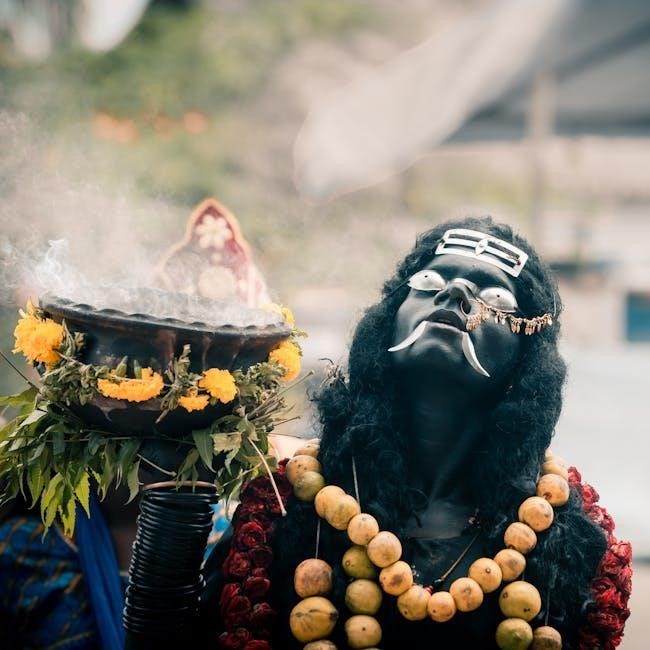Lalita Sahasranama is an ancient Hindu hymn dedicated to Goddess Lalita, a form of Goddess Lalita Tripurasundari. It consists of 1000 names extolling her divine attributes and virtues, revered in Shaktism.
1.1 Overview of Lalita Sahasranama
Lalita Sahasranama is a sacred Hindu hymn comprising 1000 names of Goddess Lalita, a divine form of Shakti. It is a revered text in Shaktism, celebrating her cosmic manifestations and spiritual significance. The hymn is structured as a stotra, offering deep insights into her attributes and worship. Originating from the Brahmanda Purana, it is chanted for spiritual growth and devotion. In Tamil, it is widely available as PDFs, including rare commentaries by scholars like G. V. Ganesa Iyer, making it accessible for devotees to recite and reflect upon her divine glory.
1.2 Importance of Lalita Sahasranama in Hinduism
Lalita Sahasranama holds immense significance in Hinduism, particularly in Shaktism, as it embodies the divine essence of Goddess Lalita. It is revered as a powerful tool for spiritual growth, offering insights into her cosmic manifestations and attributes. Originating from the Brahmanda Purana, the hymn is chanted for devotion, worship, and to seek divine grace. Its recitation is believed to confer blessings, prosperity, and liberation, making it a cornerstone of Hindu spiritual practices. Additionally, its availability in Tamil PDF formats has made it accessible to a broader audience, enhancing its cultural and religious impact.

Significance of Lalita Sahasranama
Lalita Sahasranama is a revered hymn in Hinduism, cherished for its spiritual and devotional significance. It serves as a powerful tool for meditation, self-realization, and divine connection.
2.1 Spiritual and Religious Significance
Lalita Sahasranama holds profound spiritual and religious importance as it embodies the divine essence of Goddess Lalita. It is a sacred hymn that encapsulates her benevolent attributes, fostering devotion and spiritual growth. The text is often recited in rituals and meditative practices to seek divine grace and inner peace. Its philosophical depth provides insight into the nature of the divine feminine, making it a revered tool for spiritual seekers. Regular recitation is believed to purify the mind, bestow blessings, and strengthen one’s connection with the divine. It is a cornerstone of Shaktism, guiding believers toward enlightenment and self-realization.
2.2 Benefits of Chanting Lalita Sahasranama
Chanting Lalita Sahasranama is believed to bring profound spiritual and worldly benefits. It purifies the mind, grants divine grace, and fosters a deep connection with Goddess Lalita. Regular recitation is said to bestow blessings for health, prosperity, and happiness. It also helps in overcoming life’s challenges and negative energies. The hymn’s vibrations are known to create a calming effect, aiding in meditation and emotional balance. Devotees believe it enhances spiritual growth, leading to self-realization and enlightenment. Additionally, chanting is thought to fulfill desires and bring fulfillment to one’s life, making it a powerful practice in Hindu spirituality.

Structure of Lalita Sahasranama
Lalita Sahasranama consists of 1000 divine names of Goddess Lalita, organized into sections and stanzas, each extolling her virtues and attributes in a structured poetic form.
3.1 The 1000 Names of Goddess Lalita
The 1000 names of Goddess Lalita are a profound expression of her divine attributes, each name encapsulating her roles as creator, protector, and destroyer. These names are divided into sections, reflecting her cosmic and intimate aspects. The hymn begins with “Srimata,” signifying her role as the divine mother, and progresses through names that highlight her beauty, power, and grace. Each name is a mantra, believed to hold spiritual significance and the power to invoke her blessings. The structure is both poetic and philosophical, making it a revered text for devotion and contemplation.
3.2 Division into Sections and Stanzas
Lalita Sahasranama is organized into sections, each containing specific groups of names that highlight different aspects of Goddess Lalita. The text is divided into themes, such as her cosmic roles, divine attributes, and spiritual significance. Each section is further subdivided into stanzas, which are rhythmic and poetic, making it easier for devotees to recite and meditate. The structure follows a traditional format, ensuring the hymn flows harmoniously while maintaining its spiritual depth and philosophical richness.

Lalita Sahasranama in Tamil
Lalita Sahasranama is widely available in Tamil, offering devotees a profound spiritual connection through its translation; The Tamil version preserves the hymn’s divine essence and cultural significance.
4.1 Availability of Tamil Translations
Tamil translations of Lalita Sahasranama are widely available, enabling devotees to access the sacred hymn in their native language. PDF versions, such as the rare Tamil commentary by G. V. Ganesa Iyer, can be freely downloaded from platforms like Scribd. Additionally, websites like the Austin Hindu Temple offer downloadable Tamil scripts of Lalita Sahasranama. These resources ensure that the spiritual text remains accessible to Tamil-speaking followers, preserving its cultural and religious significance. Many online platforms also provide free PDF downloads, making it easier for devotees to study and recite the hymn for spiritual enrichment.
4.2 Prominent Scholars and Commentaries in Tamil
Renowned scholars have contributed to the interpretation and translation of Lalita Sahasranama in Tamil. G. V. Ganesa Iyer’s rare Tamil commentary is a seminal work, offering deep insights into the hymn’s spiritual essence. His commentary is widely respected and is available as a free PDF download. Additionally, Sree Bhaskararaya’s “Soubhagya Bhaskaram,” though originally in Sanskrit, has influenced Tamil translations, blending philosophical depth with devotion. These scholarly works have enriched the understanding of Lalita Sahasranama in Tamil, making it accessible to a broader audience while preserving its cultural and spiritual significance.
Downloading Lalita Sahasranama PDF in Tamil
Lalita Sahasranama in Tamil PDF is widely available for free download on reliable websites like Austin Hindu Temple and Scribd, ensuring easy access for devotees globally.
5.1 Reliable Sources for Download
Reliable sources for downloading Lalita Sahasranama PDF in Tamil include reputable websites like Austin Hindu Temple and Scribd. These platforms offer free access to the sacred text, ensuring authenticity and cultural significance. Devotees can trust these sources for accurate and spiritually meaningful versions of the stotra. Additionally, they provide easy navigation and download options, making it convenient for users to access the PDF without hassle. These sources are widely recognized within the Hindu community for their reliability and commitment to preserving sacred texts.
5.2 Free Resources and Websites
Several free resources and websites offer Lalita Sahasranama PDF in Tamil, including Scribd, Google Drive, and Austin Hindu Temple. These platforms provide easy access to the stotra, ensuring devotees can download it without cost. Additionally, websites like telugudevotionalswaranjali.blogspot.com and Scribd document links offer free PDF versions. These resources are trusted for their authenticity and convenience, making the sacred text accessible to everyone. They cater to spiritual seekers and devotees, promoting the widespread dissemination of Lalita Sahasranama in Tamil.

Key Themes in Lalita Sahasranama
Lalita Sahasranama explores themes of devotion, divine attributes, and spiritual growth, emphasizing Goddess Lalita’s cosmic role and divine grace, inspiring worshippers to seek enlightenment and inner peace.
6.1 Devotion and Worship of Goddess Lalita
The Lalita Sahasranama embodies profound devotion to Goddess Lalita, highlighting her compassionate and nurturing aspects. Each name in the text reflects her divine qualities, fostering a deep connection with devotees. The hymn is often recited in temples and homes, serving as a powerful medium for worship and spiritual growth. By chanting her names, followers seek her blessings and guidance, believing it strengthens their faith and brings solace. This ancient practice continues to inspire millions, making Lalita Sahasranama a cornerstone of Shakti worship.
6.2 Philosophical Insights and Spiritual Growth
Lalita Sahasranama offers profound philosophical insights into the nature of existence, divine consciousness, and the universe. Each name of Goddess Lalita symbolizes a unique aspect of her cosmic and nurturing essence, guiding seekers toward self-realization. The text emphasizes the unity of Shiva and Shakti, illustrating the interplay of masculine and feminine energies. By contemplating these names, devotees gain spiritual clarity and inner peace, fostering a deeper connection with the divine. This sacred hymn serves as both a devotional and philosophical guide, aiding in the journey toward spiritual enlightenment and liberation.
The Role of Lalita Sahasranama in Daily Life
Lalita Sahasranama brings spiritual solace and balance to daily life, fostering mindfulness and resilience. Its recitation helps devotees connect with divine energy, promoting emotional well-being and inner harmony.
7.1 Incorporating the Stotra into Daily Prayer
Incorporating Lalita Sahasranama into daily prayer enriches spiritual practice, fostering a deeper connection with Goddess Lalita. Many devotees chant it during morning prayers to invoke divine energy and blessings. Reciting the stotra with mindfulness and intention helps purify the mind and attract positive vibrations. It is often chanted during pivotal life moments or to seek solace in challenging times. The hymn’s verses can be integrated into meditation or puja rituals, enhancing their efficacy. Regular recitation cultivates devotion, balance, and inner peace, making it a powerful tool for daily spiritual growth and harmony.
7.2 Using Lalita Sahasranama for Meditation
Lalita Sahasranama is a powerful tool for meditation, offering a profound spiritual experience. Its rhythmic verses and divine meanings help quiet the mind and focus on the divine. Chanting each name with intention fosters mindfulness and devotion, creating a meditative state. Regular meditation with this stotra is believed to reduce stress, enhance inner peace, and deepen self-awareness. The thousand names of Goddess Lalita guide the practitioner toward spiritual growth and harmony. Many devotees use Tamil PDF versions of Lalita Sahasranama for easy access during meditation sessions, further enhancing their spiritual journey.

Cultural and Historical Context
Lalita Sahasranama originates from the Brahmanda Purana, reflecting rich cultural and historical significance in Hinduism. Its Tamil translations have deeply influenced spiritual practices and rituals in South India.
8.1 Origins and Evolution of Lalita Sahasranama
Lalita Sahasranama, a sacred Hindu hymn, originates from the Brahmanda Purana, a foundational text in Shaktism. It is part of the larger Lalita Sahasranama Stotram, which praises Goddess Lalita Tripurasundari, a supreme deity in Hindu spirituality. Over centuries, the hymn evolved through interpretations and commentaries by scholars, blending philosophical insights with spiritual practices. Its adaptation into Tamil reflects its regional influence, with translations and commentaries by Tamil scholars enhancing its accessibility. This evolution underscores its enduring significance as a revered text for worship, meditation, and spiritual growth in both Sanskrit and Tamil traditions.
8.2 Influence of Lalita Sahasranama on Tamil Culture
Lalita Sahasranama has profoundly shaped Tamil cultural and spiritual life, particularly in its devotional practices. The hymn’s integration into temple rituals and daily worship has deepened reverence for Goddess Lalita in Tamil Nadu. Prominent Tamil scholars, such as G. V. Ganesa Iyer, have contributed to its popularity through rare commentaries and translations, making it accessible to Tamil-speaking devotees. This sacred text has inspired literary and musical compositions, embedding it as a cornerstone of Tamil spiritual heritage, fostering devotion, and enriching cultural expressions.

Lalita Sahasranama and Its Connection to Other Scriptures
Lalita Sahasranama draws connections to the Vedas, Upanishads, and other Hindu scriptures, reflecting shared philosophical themes. It aligns with texts like Vishnu Sahasranama, enriching Hindu spiritual philosophy.
9.1 Links to Vedas and Upanishads
Lalita Sahasranama deeply connects to Vedic and Upanishadic philosophies, reflecting concepts like Maya, Prakriti, and the ultimate reality. It embodies the Vedic ideals of the divine feminine, aligning with the Upanishads’ monistic views of Brahman. The text resonates with the Rigveda’s hymns to the goddess, while its spiritual essence mirrors the Upanishads’ teachings on self-realization and cosmic unity. These links underscore its roots in ancient Indian philosophy, bridging ritualistic worship with profound philosophical inquiry.
9.2 Comparison with Other Sahasranamas
Lalita Sahasranama stands distinct among other Sahasranamas like Vishnu and Shiva Sahasranama, focusing on the divine feminine. It uniquely blends devotion, philosophy, and ritual, emphasizing Goddess Lalita’s cosmic role. Unlike others, it includes both stotra and namavalis, with specific sections like Sahasranama and Sahasranamam. While Vishnu Sahasranama highlights masculine divine attributes, Lalita Sahasranama glorifies the feminine principle, offering a holistic view of spirituality. Its structure and depth make it a revered text for both worship and self-realization, appealing to a broader spectrum of spiritual seekers.

The Role of Lalita Sahasranama in Temples and Rituals
Lalita Sahasranama is integral to temple rituals, chanted during festivals and ceremonies to invoke Goddess Lalita’s blessings; Its recitation is believed to enhance spiritual connection and divine grace.
10.1 Temple Worship and Ceremonies
Lalita Sahasranama is an integral part of temple worship, recited during pujas, festivals, and special ceremonies. It is chanted to invoke Goddess Lalita’s divine presence and blessings. Temples often organize recitation sessions during Navaratri, emphasizing its spiritual significance. Priests and devotees recite the hymn with dedication, creating a sacred atmosphere. The Tamil version of Lalita Sahasranama is widely used in temple rituals, connecting devotees with the deity. This practice strengthens faith and fosters a deeper spiritual connection, making it a vital component of temple worship traditions.
10.2 Rituals Associated with Lalita Sahasranama
Lalita Sahasranama is deeply intertwined with specific rituals, enhancing its spiritual significance. Devotees often perform homas, where the hymn is chanted to purify and seek divine blessings. Rituals include recitation during auspicious days like full moons or festivals. In Tamil traditions, the Sahasranama is sometimes recited alongside offerings to Goddess Lalita, ensuring prosperity and spiritual growth. These rituals are conducted with precision, emphasizing devotion and the hymn’s sacred power. They serve as a bridge between the devotee and the divine, fostering a profound connection and inner peace.

Lalita Sahasranama as a Tool for Self-Realization
Lalita Sahasranama serves as a powerful tool for self-realization, guiding seekers through its sacred names to attain spiritual enlightenment and understand the divine within, fostering inner harmony.
11.1 The Power of Each Name
Each name in Lalita Sahasranama is a potent mantra, encapsulating the divine attributes of Goddess Lalita. These names are not mere praises but carry profound spiritual energy, guiding seekers toward self-realization. Chanting each name invokes its specific power, fostering devotion, clarity, and inner transformation. The names are structured to awaken consciousness, helping the devotee connect with the divine feminine energy. Through repetition, one experiences spiritual growth, realizing the true nature of the self and the universe. This sacred text thus serves as a bridge between the mundane and the transcendental, empowering individuals on their journey to enlightenment and inner harmony.
11.2 Journey Toward Spiritual Enlightenment
Lalita Sahasranama serves as a profound guide for seekers of spiritual enlightenment. Each name in the stotra is a step toward self-discovery, helping devotees transcend worldly attachments. By chanting the Sahasranama, one experiences a deep connection with the divine feminine energy, dissolving the ego and revealing the true self. The hymn’s structure and rhythm facilitate introspection, leading to a harmonious balance between material life and spiritual aspirations. Through consistent recitation, practitioners attain clarity, inner peace, and ultimately, liberation (moksha), embodying the essence of spiritual enlightenment.

Lalita Sahasranama in Modern Times
Lalita Sahasranama remains relevant in modern times through digital accessibility. PDF downloads in Tamil enable devotees to recite and reflect on its teachings with ease and convenience.
12.1 Digital Availability and Accessibility
In today’s digital age, Lalita Sahasranama in Tamil is widely accessible. Devotees can easily download PDF versions from platforms like Scribd and Austin Hindu Temple’s website. Rare commentaries, such as G. V. Ganesa Iyer’s Tamil Bhashyam, are also available for free. This digital convenience ensures that the sacred text reaches a global audience, fostering spiritual connection and ease of recitation for modern practitioners.
12.2 Impact on Contemporary Spirituality
Lalita Sahasranama’s digital presence has revitalized its role in modern spirituality. The availability of Tamil PDFs and audio links has made it accessible to a younger, tech-savvy generation. This shift has allowed devotees to incorporate the stotra into daily meditation and worship, fostering a deeper connection to Goddess Lalita. The ease of access has also inspired new interpretations and discussions, blending traditional reverence with contemporary practices and ensuring its relevance in today’s spiritual landscape.
Lalita Sahasranama remains a profound spiritual text, now widely accessible in Tamil PDF formats. Its digital availability has ensured its enduring relevance, inspiring devotion and spiritual growth globally.
13.1 Summary of Key Points
Lalita Sahasranama is a revered Hindu text, comprising 1000 names of Goddess Lalita, symbolizing her divine attributes and spiritual significance. It is widely available in Tamil PDF formats, enabling devotees to access its teachings effortlessly. The text emphasizes devotion, spiritual growth, and the pursuit of self-realization. By incorporating Lalita Sahasranama into daily prayers and meditation, individuals can attain mental peace and clarity. Its cultural and historical roots deepen its relevance, while its digital accessibility ensures its timeless appeal. This sacred text remains a cornerstone of Hindu spirituality, guiding seekers toward enlightenment and inner harmony.
13.2 Final Thoughts on Lalita Sahasranama
Lalita Sahasranama is a powerful hymn that embodies the essence of divine worship and spiritual growth. Its availability in Tamil PDF formats has made it accessible to a broader audience, ensuring its timeless relevance. This sacred text not only deepens devotion but also serves as a guide for self-realization and inner peace. By embracing Lalita Sahasranama, seekers can experience profound spiritual transformation, aligning with its teachings in daily life. Its enduring significance in Hinduism underscores its role as a beacon of enlightenment, inspiring generations to seek harmony and divine connection.


